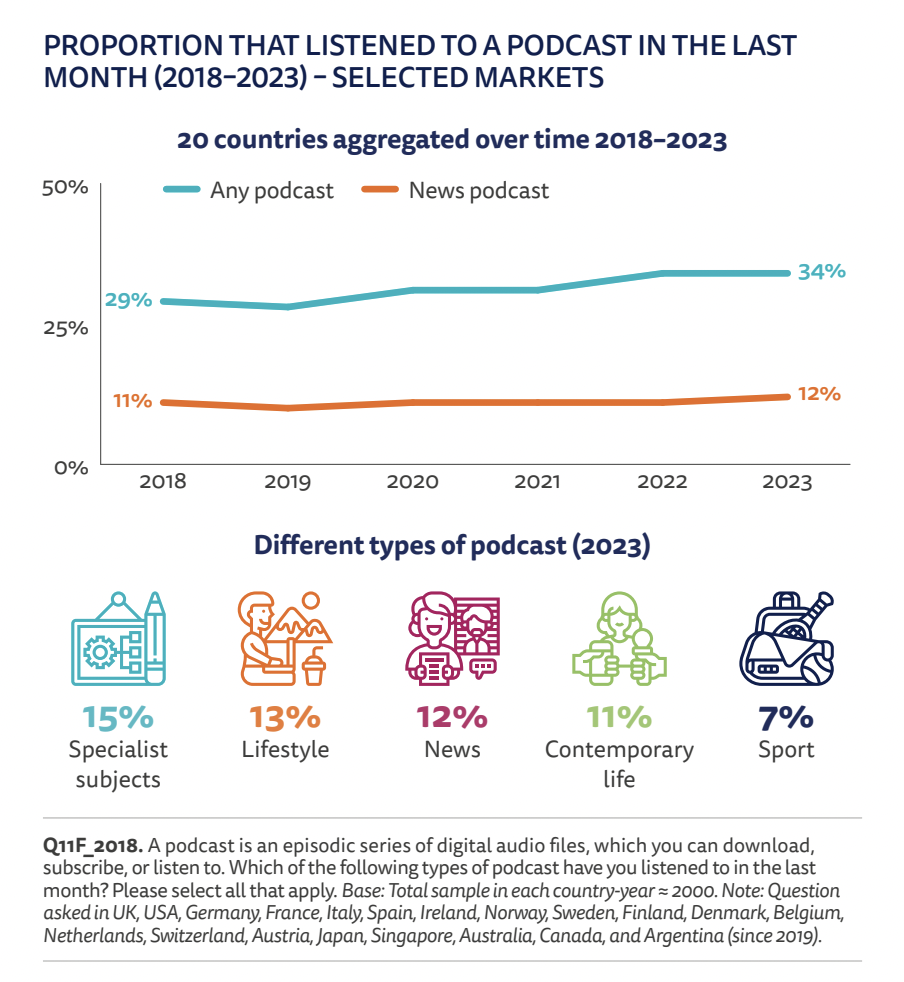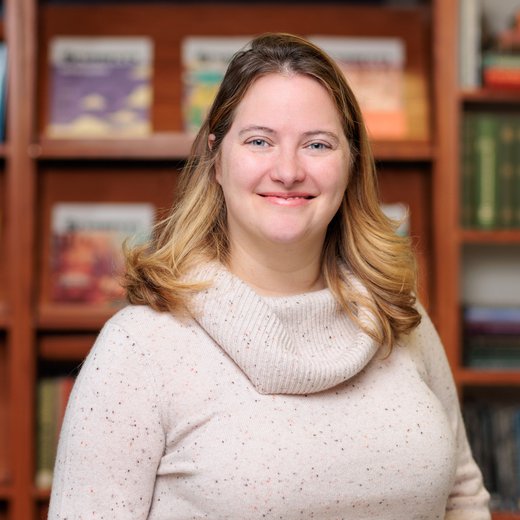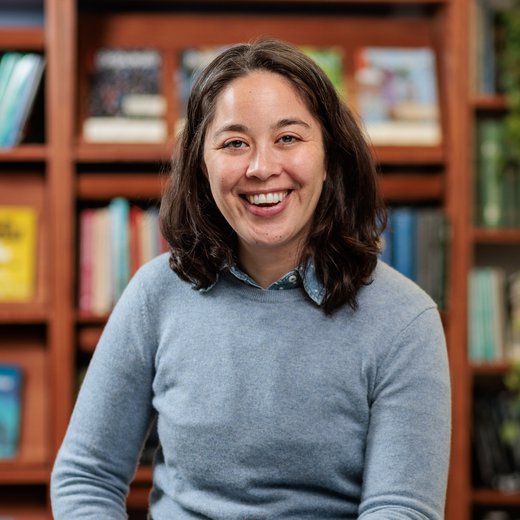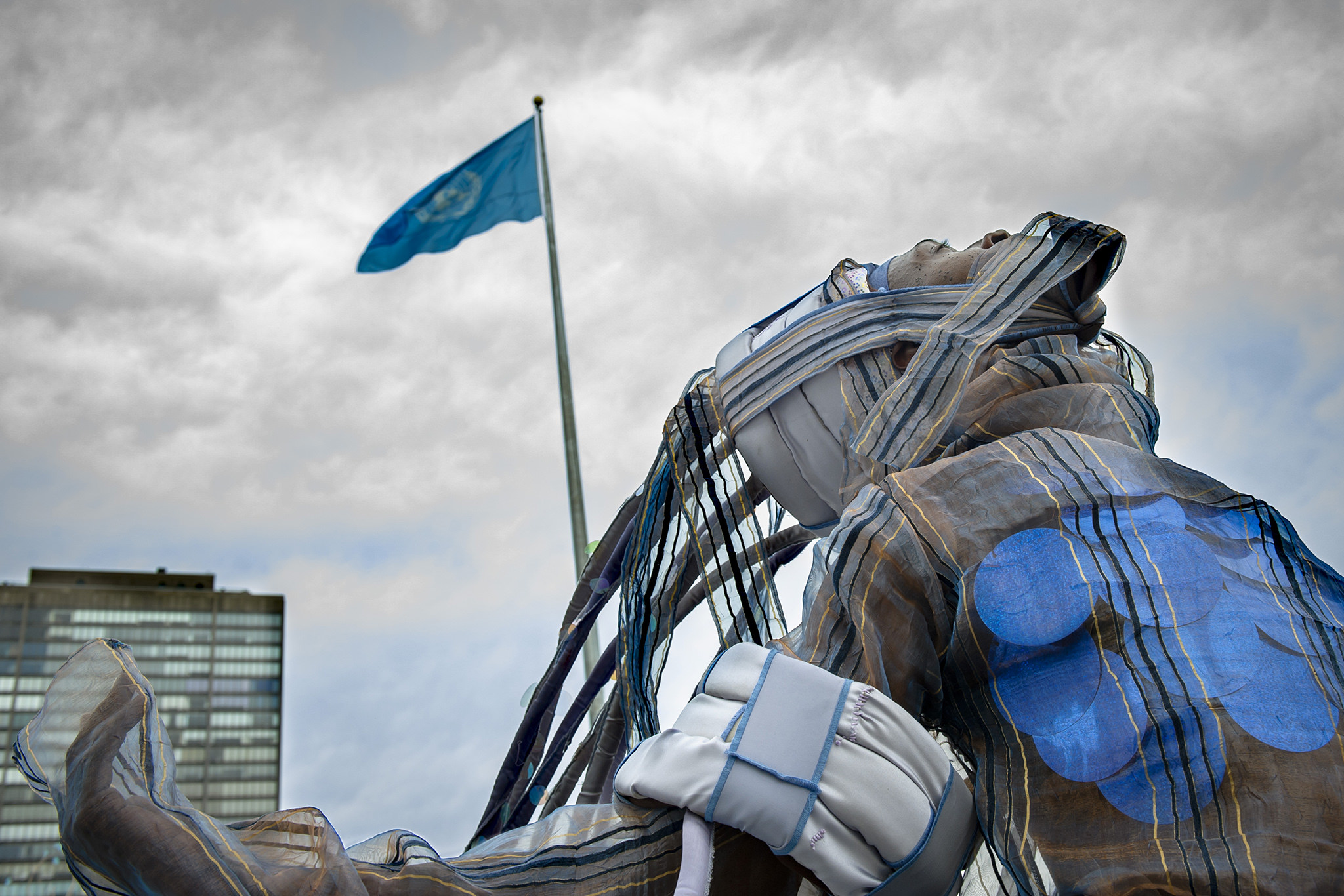Richer, better educated, and crucially much younger. The profile of podcast listeners is coming to light thanks to a study by the Reuters Institute for the Study of Journalism, which since 2018 has tracked monthly podcast use in 20 countries (detailed in Figure 1) with a well-developed podcast industry. Across these markets, overall podcast usage has grown in the past five years from just over a quarter to about a third of the international survey sample.

15% of Reuters Institute’s survey respondents access a specialist subject podcast regularly. Under this category, podcasts related to climate change issues are growing along with the public attention for the topic.
At CMCC, we have recently produced our first podcast series, Foresight – Deep into the Future Planet, because we like to experiment with languages and tools that help to effectively tell the story of crisis and transition between climate and people, science and society.
RFF, Resources for the Future is a research institution launched its weekly podcast in December 2018. We interviewed Elizabeth Wason – the producer – and Kristin Hayes – one of the co-hosts – to know more about what is behind Resources Radio.
What does it add to having a podcast to communicate climate science?
Text-based communication about climate science and other related topics, particularly from a research organization, may be intimidating to some audiences. Articles can be dense, full of jargon, a little too “official.” RFF’s more technical publications are an important part of our research and communications strategy, though they sometimes assume that the reader has some existing knowledge and interest. The podcast intentionally makes no such assumption. Technical terms aren’t part of the conversation—or, if they appear, are defined clearly alongside any minimal use of acronyms. The podcast is deliberately casual, and we might say that the primary aim is to draw people in, rather than push information out.
How would you describe Resources Radio?
The target audience of Resources Radio includes policymakers, decisionmakers, academics, and casual energy/environment enthusiasts. We’d like the podcast to be accessible to a broad range of listeners, including non-experts such as energy/environmental business practitioners, undergraduates who are interested in energy/environment, and more. We keep the conversation fairly informal and seek to minimize technical elements such as detailed descriptions of statistical techniques or other research methods, acronyms, and jargon. The subject matter tends to cover rigorous research into a broad range of energy and environmental issues.
The episode format is deliberately structured so that each episode can feel familiar to regular listeners. The host always starts with a question about the guest’s background, including how they became interested in energy or environmental topics, and perhaps what formative experiences the guest might share from their career. The host then proceeds to the core subject matter, usually focused on new research, which typically includes the research motivation, non-technical methods, key findings, policy (or other implications), and next steps. Every episode closes with a “Top of the Stack” segment, in which the guest briefly describes a recent publication, film, podcast, event, or some other form of media that they’ve found particularly interesting.
Why did you decide to add a podcast to your editorial projects?
The podcast has been an important addition to our editorial channels, and a few considerations surely motivated the decision to launch Resources Radio. The team at RFF wanted to diversify our content and take advantage of a growth medium that could both attract new audiences and serve as another channel for communicating to a general (rather than technical or academic) audience. We also wanted to find new ways of engaging with our existing audience, offering content that we knew our readers would be interested in, but that they could enjoy in a different context without needing to focus attention fully on text or a screen—perhaps instead by listening while commuting or washing dishes. We also figured that a podcast would be a nice way to incorporate broader expertise that may not be within RFF’s primary wheelhouse, and to invite diverse perspectives from outside of our organization—though also of course to introduce RFF’s audience to some of our own in-house experts.
How does the podcast fit in with the overall communication strategy of Resources for the Future as a research centre?
In terms of our editorial channels, the podcast is one of three main offerings alongside our magazine and blog. While all editorial channels are intended to spread RFF’s research broadly and beyond academic and technical audiences, the podcasting medium helps us tap into an audience that may not be ready-made for our text articles.
Audio/podcasting provides another means through which RFF can facilitate organic growth of our audience. Podcast apps do a lot of the dissemination work, which means that those push notifications produce rewards for RFF relatively passively. Listeners can subscribe through the platform of their choice, rather than the platform of our choice—a unique freedom. We can gain a loyal audience by offering regularly scheduled programming with a consistent format that listeners can grow to love and look forward to. And we’ve found anecdotally that the podcast is a medium that educators find useful to share in the classroom.
The podcast is a nice element of our communications strategy that guarantees a weekly touch with our audiences. Honing our podcast process has helped us maximize the efficiency of our efforts, based on the jumping-off point of deliberate planning early on.
Finally, the podcast enables us to diversify our content beyond the direct research expertise housed within our organization—it allows us (via the hosts) to briefly explore topics that RFF wouldn’t necessarily dig into otherwise.
How do you select hosts and Interviewees, who are different in each episode?
Resources Radio has three different hosts: Daniel Raimi, Kristin Hayes, and Margaret Walls. We opted for three hosts in part because we wanted to share the work of recording weekly episodes among multiple people, but also because the different hosts bring different interests, perspectives, styles, and expertise to the episodes they record. This leads to a nice diversity of topics and conversations over time.
Each of the hosts is largely responsible for identifying the topics they wish to discuss and the guests with which they wish to discuss them–but we do gather as a team on a fairly regular basis to brainstorm ideas in both areas. We also hand off suggestions for topics and guests to other hosts, when one person feels another host might be best suited to lead the conversation.
Resources Radio is a weekly podcast. How many people listen to your episodes every week?
Episodes that have been around for a while average about 2,500 listens. Newer episodes average about 1,500 plays. Last year, Resources Radio episodes accumulated about 126,000 plays. This year, the podcast is on track to exceed 140,000.
In your experience, what is the key to giving voice to the science and scientists in podcasts while keeping the audience’s attention high?
Great question. This is one of the reasons we always start with an introduction to the episode guest: we want to make sure our audience has some sense of them as a person, not just as a knowledge base. We also encourage our guests to share their insights with our target audience in mind, keeping jargon to a minimum and focusing on why the topics under discussion matter to decisionmakers and/or the broader public. Our guests consistently exceed our expectations in this effort!
What did you learn from this experience? What are the main satisfactions and difficulties that you met?
The podcast co-hosts work diligently and deliberately to ensure that the podcast features a diversity of guests, in terms of gender, ethnic background, field of expertise, affiliation (e.g., corporate, nonprofit, academic), and more. This goal is not always easy and sometimes requires persistence and creative outreach.
We could make things a bit easier on ourselves by inviting guests who already are visiting RFF, such as seminar speakers. Partnering with guest institutions to promote the podcast probably has helped to expand our audience. We’re always looking for creative ways to broaden our listenership.
A point of satisfaction is getting good feedback from our listeners and the guests themselves. People seem to love being on the podcast, and it’s nice to maintain or create new partnerships with invited guests.
One challenge is that coordinating guests, soundchecks, recordings, follow-ups, and all the other logistics involved with production is a relatively large investment of time. Collaborating on these efforts and clearly delineating the division of labor with the co-hosts and with others on the broader communications team is quite helpful.
Most recently, because the co-hosts have been juggling vacation schedules and parental leave, we’ve found it quite useful to record material which we keep in “reserve” and can wait to release. The related trade-off is that sometimes an episode can feel old or less relevant if we wait too long to broadcast it.
 Kristin Hayes joined Resources for the Future in 2009, originally supporting a large-scale, multiyear project assessing the effectiveness and costs of a range of national US energy policy options. She now acts as RFF’s Senior Director for Research and Policy Engagement, helping to develop strategy and manage initiatives on natural gas development, domestic carbon pricing options, North American energy integration, and other energy and climate topics. Hayes also has primary responsibilities for a number of convening and communications efforts at RFF.
Kristin Hayes joined Resources for the Future in 2009, originally supporting a large-scale, multiyear project assessing the effectiveness and costs of a range of national US energy policy options. She now acts as RFF’s Senior Director for Research and Policy Engagement, helping to develop strategy and manage initiatives on natural gas development, domestic carbon pricing options, North American energy integration, and other energy and climate topics. Hayes also has primary responsibilities for a number of convening and communications efforts at RFF.
 Elizabeth Wason joined Resources for the Future in summer 2019 and helps produce RFF’s Resources magazine, the Common Resources blog, and the Resources Radio podcast. Wason has years of experience as a science communicator. Previously, she covered science research at the University of Michigan’s College of Literature, Science, and the Arts (LSA), making complex research accessible through articles published in LSA’s alumni magazine and website; she also co-created LSA’s How to Science podcast. Wason has a background in audio production and broadcasting, with years of experience volunteering at WCBN-FM on Michigan’s campus and producing a handful of radio shows, including hugabug, a podcast about the weirdness of animals. She loves collaborating closely with designers, has a habit of joining book clubs, and eats cheese.
Elizabeth Wason joined Resources for the Future in summer 2019 and helps produce RFF’s Resources magazine, the Common Resources blog, and the Resources Radio podcast. Wason has years of experience as a science communicator. Previously, she covered science research at the University of Michigan’s College of Literature, Science, and the Arts (LSA), making complex research accessible through articles published in LSA’s alumni magazine and website; she also co-created LSA’s How to Science podcast. Wason has a background in audio production and broadcasting, with years of experience volunteering at WCBN-FM on Michigan’s campus and producing a handful of radio shows, including hugabug, a podcast about the weirdness of animals. She loves collaborating closely with designers, has a habit of joining book clubs, and eats cheese.






